2012 VOLKSWAGEN GOLF PLUS lock
[x] Cancel search: lockPage 196 of 541
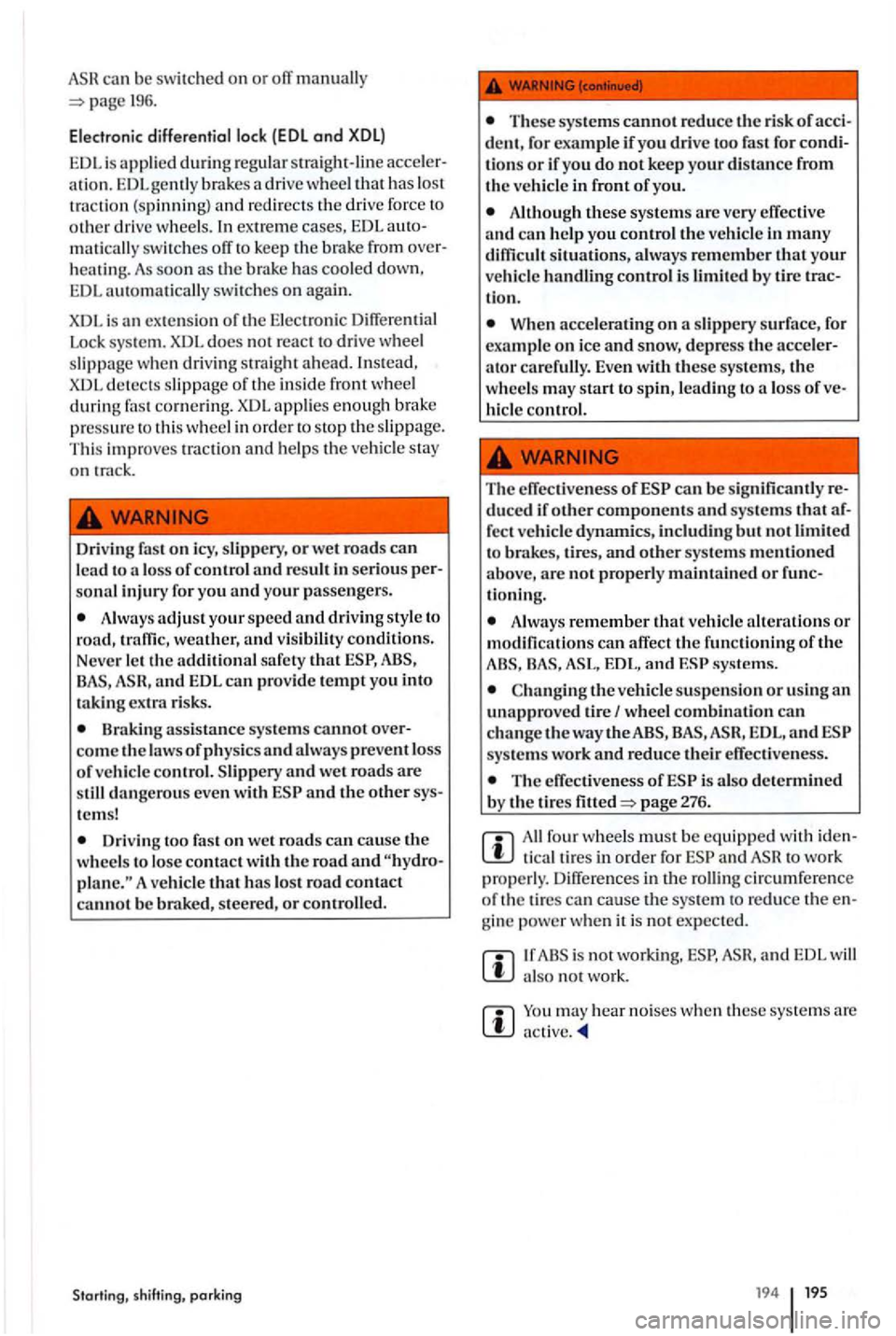
can be swi tched on or off
196.
Electr onic differential lock (EDL ond XDL)
EDL is applied during regular straight-li ne at ion. brake s a drive wheel that has lost
trac tio n (sp inn ing) and r edi rects the drive force to
o th er drive whee ls. In ext re m e cases, EDL from h eating. As soon
loss of contro l a nd result in serious sonal inju ry for yo u and yo ur passe ngers.
A lw ays adjust your s peed and driv in g s ty le to
road, traffic,
r is ks.
B rakin g ass istance syste m s cannot come th e laws of p h ys ics an d always prevent loss
o f vehi cle control. Slipp ery and wet roads are
s till da ngero us eve n with
te ms!
D rivin g to o fast on wet roads cause th e
w heels to lose contact w ith the road and A vehicl e that h as los t road contact
canno t b e brake d, steered , or controlled .
Start ing, sh ifti ng, parkin g
These syste ms cannot red uce th e risk of
Althoug h th ese syste m s a re very eff ec tive
a nd can h elp yo u control tile ve hicle in man y
diffi cult situatio ns, always remember th at your vehicle
W hen acce le ra tin g o n a slippery surface, fo r
exam ple o n icc and sn ow, depress the
''
can b e sig nificantl y duced if other components and sys tems that
ti onin g.
A lways re m ember th at ve hicl e
syste m s.
Cha nging the vehi cle su sp ens io n or using an unapproved tire w heel combinati on ca n
c h a ngethewayth eABS, EDL, and syste ms work and reduce their effecti ve ness.
T he effective ness of page 276 .
All fo ur w hee ls must b e equip ped with tic a l tir es in order for to wo rk
properly. Differences in th e
g ine powe r w he n it is not expected.
I f is not working, and EDL will also not work.
active.
Page 197 of 541
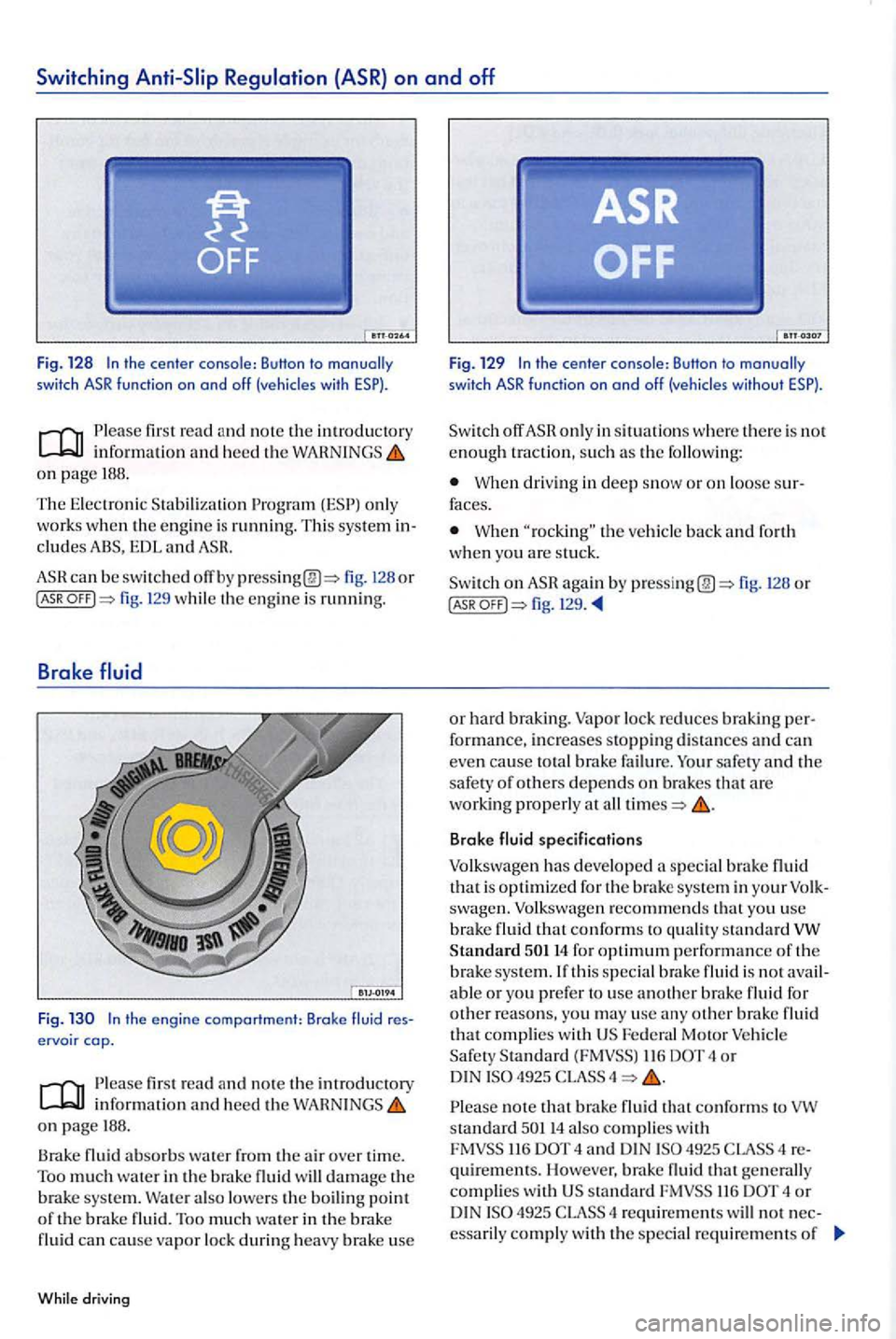
Switching
the center console: Button to with
Please fir st read and no te the introductory informatio n and heed the on page
The Electronic Stabili zation Program
cludes
can b e switched off by fig. (ASR fig. 129 whil e th e engi ne is running.
B rake
ervoir cop.
Please fir st r ead and note the introductory information and heed the on page 188.
Brake fluid
absorbs wate r from the air over time. Too much water in the brake fluid will damage the brake system. Wa te r a lso lowers th e boiling point o f the brake fluid. Too much wate r in the brake
fluid can cause vapor lock during heavy brake use
Whi le driving
Fig. 12 9 the center console: Button to switc h function on and without
off only in situations w here there is not enough traction, s u ch as the fo llo wing:
When driving in deep snow o r o n loose faces.
W hen
on again by fig. 128 or (ASR fig. 129 .
or hard braking. Vapo r lock reduces braking
safety and the safe ty of others d e pends o n brakes that are working properly at all
Brake
swagen. Volkswagen recommends that yo u use brake fluid that conforms to quality standard 14 for optimum p erformance of the brake system. If this s pecial brake fluid is not
Motor Vehicle 116 4 or 4
Please note that brake fluid that conforms to standard 14 a lso complies w ith 116 4 and DIN 4 quirements. However, brake fluid that generally complies with 116 4 or 4925 CLASS 4 requirements w ill not essarily comply with the s pecial requirements of
Page 198 of 541
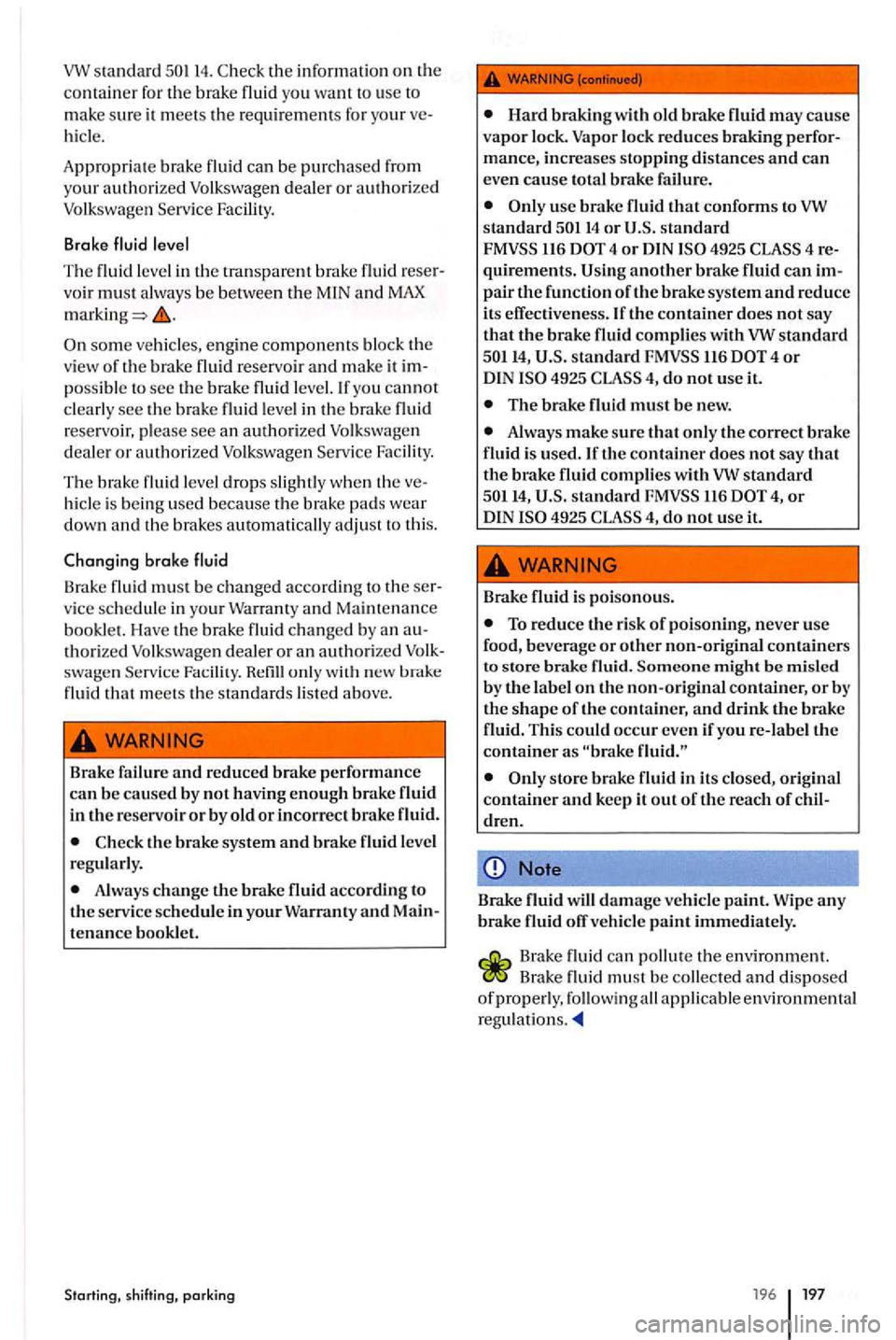
the info rm ation on the co ntainer for the brake fluid you want to use to
mak e sure it meets th e requirem ent s for your hicl e.
A ppro priat e brak e fluid can
be purchased from your authorized deal er or authori zed Facility.
Brake fluid level
The fluid
level in the transparent brake fluid voir must always be betw een th e MIN and MAX
some vehicle s, eng ine components blo ck th e
v iew of th e brake fluid reservoir and make it po ssibl e to see the brake fluid level. I f you cannot clearl y see the brake fluid leve l in the brake fluid reservoir, please see an authoriz ed deale r or authorized Facility.
The brake fluid level drop s slightl y when the hicle is being use d becaus e the brake pad s wea r
down and the brak es automatically adjust to thi s.
Changing brake fluid
Brak e fluid
must be changed a ccor ding to the
thori zed
Brake failure and reduced brake performance can be caused by not having enough brake fluid
in the reservoir or by old or incorrect brake fluid.
change brake fluid according to the service schedule in your Warranty and
lock reduces braking
standard 4925 another brake fluid can
standard 50114, 116 4 or 4925 4, do not use it.
The brake fluid must be new.
Always make sure that only the correct brake fluid is used. the container does not say that the brake fluid complies with standard 4925 4, do not use it.
Brake fluid is poi sonous.
To reduce the risk of poisoning, never use food, beverage or other non-original containers
to store brake fluid. might be misled
by the label on th e non-original container, or by the shape of the container, and drink the brake
fluid. This could occur even if you re-label the container as
dren.
Note
Brake fluid
Brake fluid can pollut e the en vironment.
196 197
Page 200 of 541
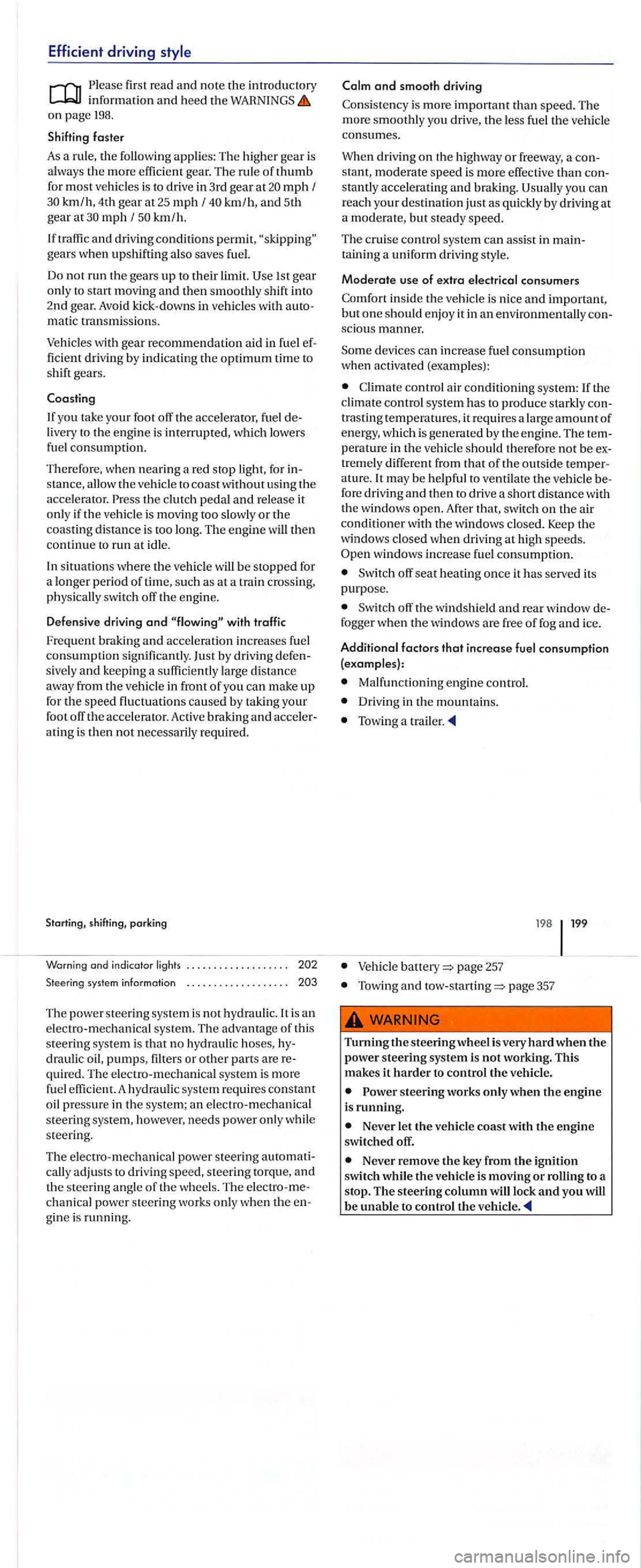
Efficient driving
Please information and heed the on page 198.
Shifting faster
As a rule, the following applies: The higher gear is
a lways the more efficient gear. The rule of thumb for most vehicles is to drive in 3rd gear at mph f km/h, 4th gear at 25 mph f km/h, and 5th gear at mph f km /h.
If
and driving conditions permit, gears when upshifting also saves fuel.
Do
not run the gears up to their limit.
mati c transmissions .
Vehicles with gear recommendation aid in fuel fic ient dri ving by indicating the optimum time to shift gears.
livery to the engine is interrupted, which lowers
fuel consumption.
T herefore, when nearing a red stop light , for s tanc e, allow the vehicle to coast without using the accelera tor. Press the clutch pedal and release it only if the v ehicle is moving too slowly or the coasting distance is too long. The engine will then continue to run at idl e.
In situati ons
where the vehicle will be stopped for
a longer period of time, such as at a train cros sing,
physically switch off the engin e.
D efens ive driving
and with traffic
Fre
quent braking and accel eration increases fuel consumption sign ific antly. Just by driving sivel y and keeping a su fficiently large distance away fro m the vehicle in front of you can make up for the speed fluctuation s caused by taking your foot off the accelerator. Active braking and ating is then not necessarily required.
system information
The power stee ring syste m i s not hydrauli c.lt is an electro-mechanical syste m. The advantage of this
s te ering system is tha t no hydra uli c hoses, draulic oil, pumps, filters or other parts are quired . Th e e lectro-m echanica l system is more fue l effi cient. A hydraulic system requires constant oil pressure in the syste m; an electro -mechanical
s teerin g sys tem, however, needs power only whil e
s teering.
Th e el
ectro-mechanical power steering
chanical power steering works only when the gin e is running.
and smooth driving
Consistency is more important than speed. The more smoothly yo u drive, the less fuel the vehicle consumes.
When driving on the highwa y or freeway, a
stantly accelerating and braking. you can r each your destinatio n just as quickly by driving at a moderate, but steady speed.
The c rui se control syste m can a ssis t in
sciou s manner.
Some dev ices can increase fuel consumption when activated (examples):
C limate control air conditioning system:
trasting temperatures, it requires a large amount of energy, which is generated by the e ngin e. T he
tr emely different from that of the outside
windows increase fuel consumption.
Switch off seat heating once it has served its
purpose.
Sw itch off the windshield and rear window
Malfunctioning engine control.
Driving in the mountains.
Towing a trailer .
page 257
Towing and page 357
Turning the steering wheel is very hard when the power steering system is not working. This makes it harder to control the vehicle.
steering works only when the engine is running.
Never let the vehicle coast with the engine switched off.
Never remove the key from the ignition
switch while the vehicle is moving or rolling to a
stop. The steering column will lock and you will be unable to control the vehicle.
Page 202 of 541
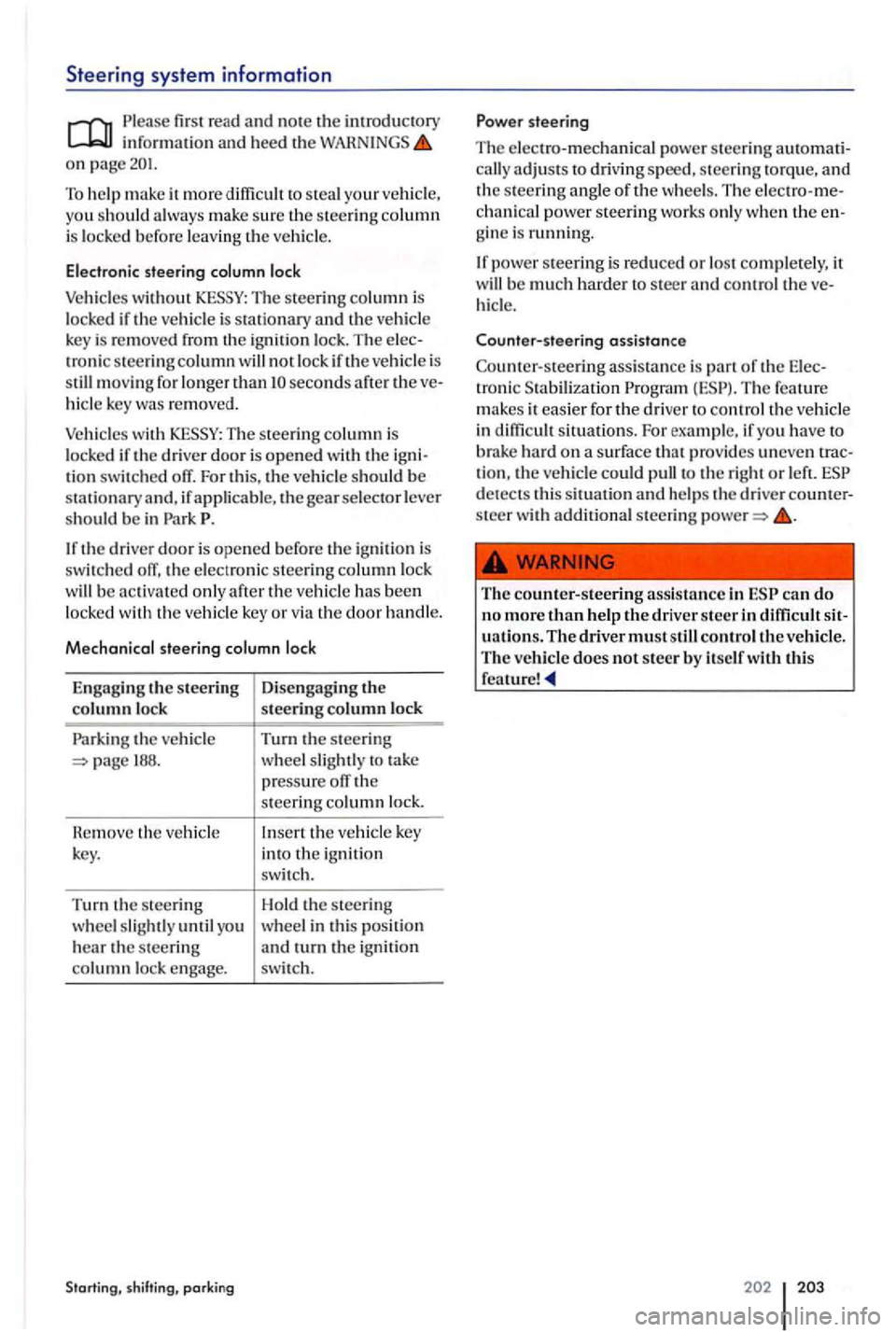
Steering system information
first read and note the introductory informatio n and heed the on page
To help m ake it more diffi cult to s teal your ve hicl e,
you sh ould always make sur e the steering co lumn is locked before leaving the ve hicle .
Electronic steering column lock
Vehicles with o
ut The s teering column is
l ocked if the vehicle is stationary and the vehicle
k ey is removed from the ign ition lock. The elec
tr onic s teering column will not lock if the vehicl e is
s till mov in g for longe r than seconds after the ve
hicl e key was re moved.
Vehicles with
Th e s teering column is
l ocked if the dri ver door is ope ned with the ignitio n switch ed ofT. For this, the ve hicle should be
s tationary if applic abl e, the gear selector leve r
s h ould be in
If the driver door is opened befo re the ign ition is
sw itch ed
188.
H e
move th e ve hicl e
k ey.
Turn th e s teering
w heel s lig htl y until you
hear the steering
column l oc k en gage.
Starting, shifting , parking
Disengaging the
steering column lock
Turn the s teering
whee l s lightl y to take pressure ofT the
s teerin g column lock.
In
sert the ve hicl e key
into the ignition swit ch .
Ho ld th e s teerin g
wheel in thi s pos ition
and turn the ignition switch.
steering
The e lectro-mechanical power steering auto m ati
c ally adjusts to dri ving speed, steering torque , and the steering angle of the wheels . The e lectro-me
c hanical power steering work s only w hen the en
gine is running.
If power steering is reduced or lost comple tely, it
will b e much harder to steer and co ntrol the ve
hicl e.
Counter-steering
assistance
T he feature
m akes it easier for the dri ver to control the vehicle
in difficult situation s. For exampl e, if yo u h ave to
brak e h
ard on a surface that provides uneve n t rac
tion, the ve hicle could pull to the right or l eft. detect s th is situation and h elps th e dri ver counter
s teer with additi onal steerin g
The counter-steering ass istance In
Page 219 of 541
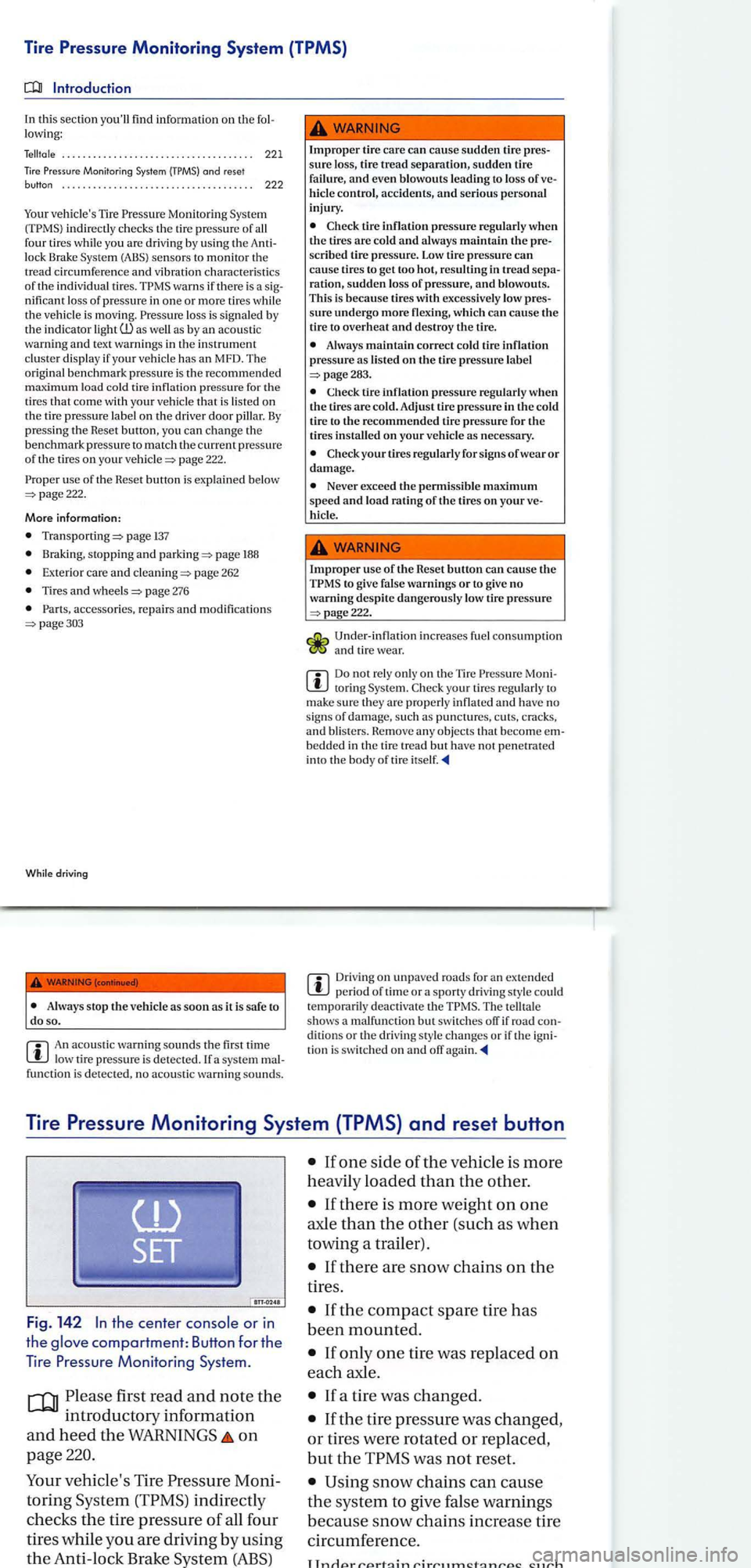
Tire Pressure Monitoring System (TPMS)
this section you'll find informati on on th e lowing:
. . . . . . . . . . . . . . . . . . . . . . . . . . . . . . . . . . . . . 221
Monitor ing System
Monito ring Sys te m indirectly c hecks the tire pressure of all
f our tires while you are driving by us ing the lock Brake Syste m (ABS) sensor s to monitor the
tr ea d circumf erenc e and vibration ch arac te ris tics of the indi vidua l tir es. warns if there is a nifi cant loss of pres sure in one or more tires while
the vehicl e is mo vin g. loss is s ig nale d b y
the ind icato r light as by an aco usti c
wa rni ng and text warnin gs in the in strument clu ster di spla y if your ve hicle has an MFD. The
origina l b en chmark pre ssure is th e recommended
m axi mum load cold tire inflati on pressure for the tire s that come with your vehicle that is lis te d on
th e tire pressure lab el on the dri ver door pill ar. By press ing the Reset button , yo u can ch ange the
b enchmark pressure to match th e c urr ent pressure of the tir es on you r page 222.
use of the Heset butto n i s explained below 222.
More informa tion:
page 137
Bra king, stopping and page 188
Ext e rior care an d page 262
page 276
pa ge303
Whil e driving
An acoustic warni ng sounds th e first time low tire pressure is detec ted. a system
Improp er tire care can cause sudden tire sure loss,
hicle control, accidents, and serious personal
injury .
tire inflation pressure regularl y when the tires are cold and alway s maintain the scribed tire pressure . Low tire pressure can cause tires to get too hot, res ultin g in tread ration, sudden lo ss of pres sure, and blowout s.
Thi s is because tires with excessively low
sure undergo more flexi ng, which can cau se the tir e to overheat and destroy the tire.
Always maintain correct cold tire inflation pressure as listed on the tire pressure label
Check tire inflation pressure regularl y when the tires are cold. Adjust tir e press ure in the cold
tir e to the recommended tire pressure for t11e tires installed on your vehicl e as necessary.
Neve r exceed the permissi ble maximum speed and load rating of the tires on your hicl e.
Imprope r us e of the Reset button can cause the to give false warnings or to give no
warning des pite dangerou sly lo w tire pressure
page222.
Und er- inflat ion increases fue l con sumptio n and tire wear.
to ring Syste m.
bedde d in the tir e tre ad but have n o t penetrated
int o the body of tire
Driving on u npaved roads for an extended
The te lltal e
s h ows a malfunc tion but switch es orr if road dit io ns or th e drivin g sty le c han ges or if th e tio n is switch ed on and orr
Tire Pressure Monitoring System (TPMS) and reset button
the center or in
the compartment: Button for th e
T
ire Pressure Monitoring System.
first r ead and note the
introductory informatio n
and heed the WARNINGS on
page
ve hicle's Tir e Moni
torin g
indirectly
c h ec ks
the ti re pressure of al l four
tire s while yo u are drivin g by us
ing
the Anti -loc k
If there is more weight on one
axle than the other (such as when
towin g a trailer) .
Page 240 of 541
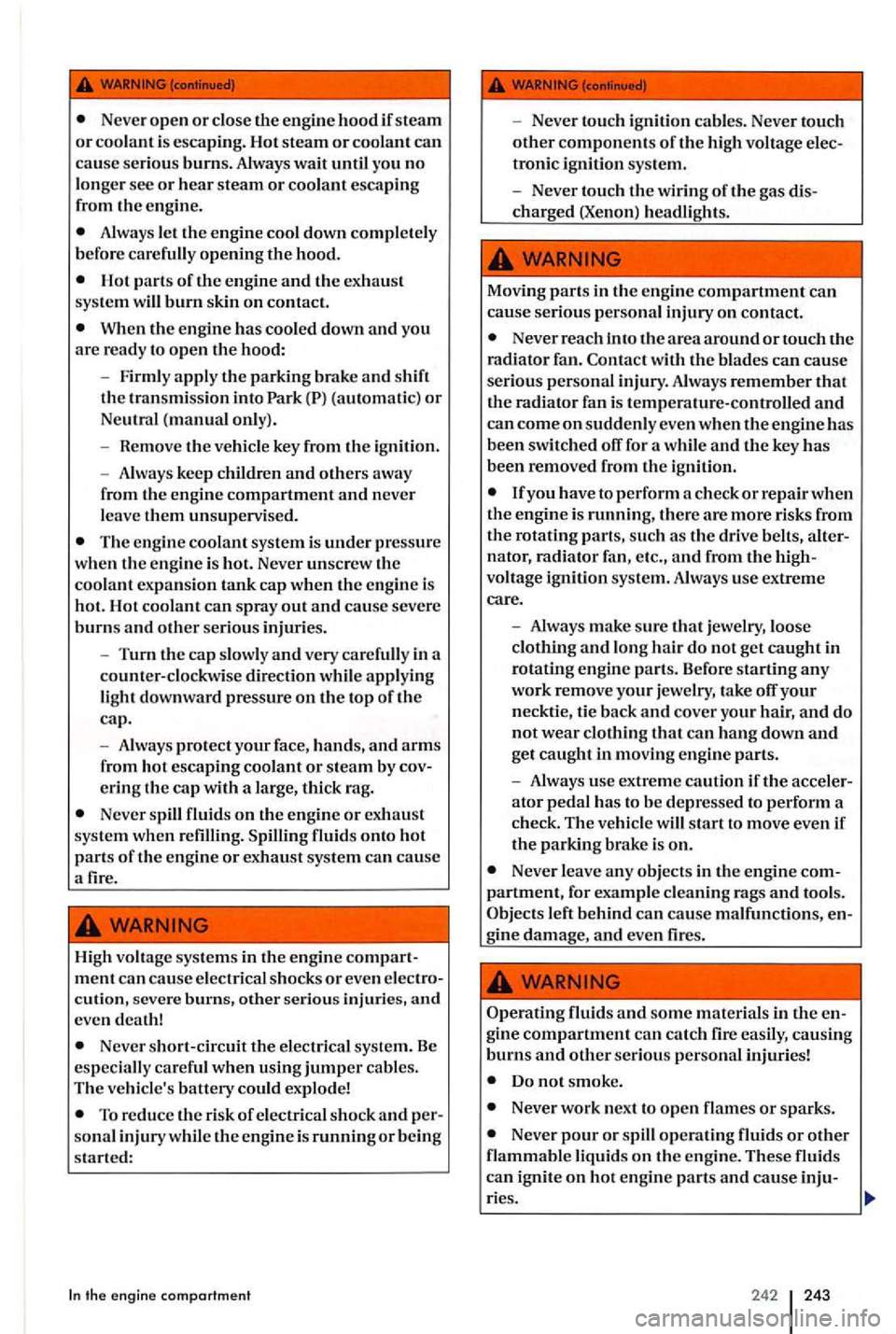
Never open or close the engine hood if steam or coolant is escaping. Hot steam or coolant can cause serious burns. Always wait until you no longer sec or hear steam or coolant escaping
from the engine.
Hot parts of the engine and the exhaust
system will burn skin on contact.
When the engine has cooled down and you are ready to open the hood:
- Firmly
apply the parking brake and shift the transmission into Park
The engine coolant system is under pressure when the engine is hot. Never unscrew the coolant expansion tank cap when the engine is
hot. Hot coolant can spray out and cause severe burns and other serious injuries.
- Turn
the cap slow ly and very carefully in a
counter-clockwise direction while applying
light downward pressure on the top of the cap.
- A
lways protect your face, hands, and arms from hot escaping coolant or steam by
Never spill fluids on the engine or exhaust
system when Spilling fluids onto hot parts of the engine or exhaust system can cause a fire.
High voltage systems in the
engine com ment can cause electrical shocks or even
Never short-circuit the electrical system. Be especially careful when using jumper cables. The vehicle's battery could explode!
To reduce the risk of electrical shock and sonal injury while the engine is running or being started:
the engine compartment
- Never touch ignition cables. Never touch other components of the high voltage tronic ignition system.
- Never touch
the wiring of the gas
Never reach into t11e area around or touch the
radia tor fan. Contact with the blades can cause serious personal injury. Always remember that the radiator fan is temperature-controlled and can come on suddenly even when the engine has been switched for a while and the key has been removed from the ignition.
lfyou have to perform a check or repair when the engi ne is running, there are more risks from tl1e rotating parts, such as the drive belts, nator, radiator fan, etc ., and from voltage ignition system. Always use extreme care.
- Always make
sure that jewelry, loose clothing and long hair do not get caught in rotating engine parts. Before starting any work remove your je welry, take
parking brake is on.
Never leave any objects in the engine
left behind can cause malfunctions,
Do not smoke.
Never work next to open flames or sparks.
Never pour or spill operating fluids or other flammable liquids on the engine. These fluids can ignite on hot en g in e parts and cause ries .
242 243
Page 241 of 541
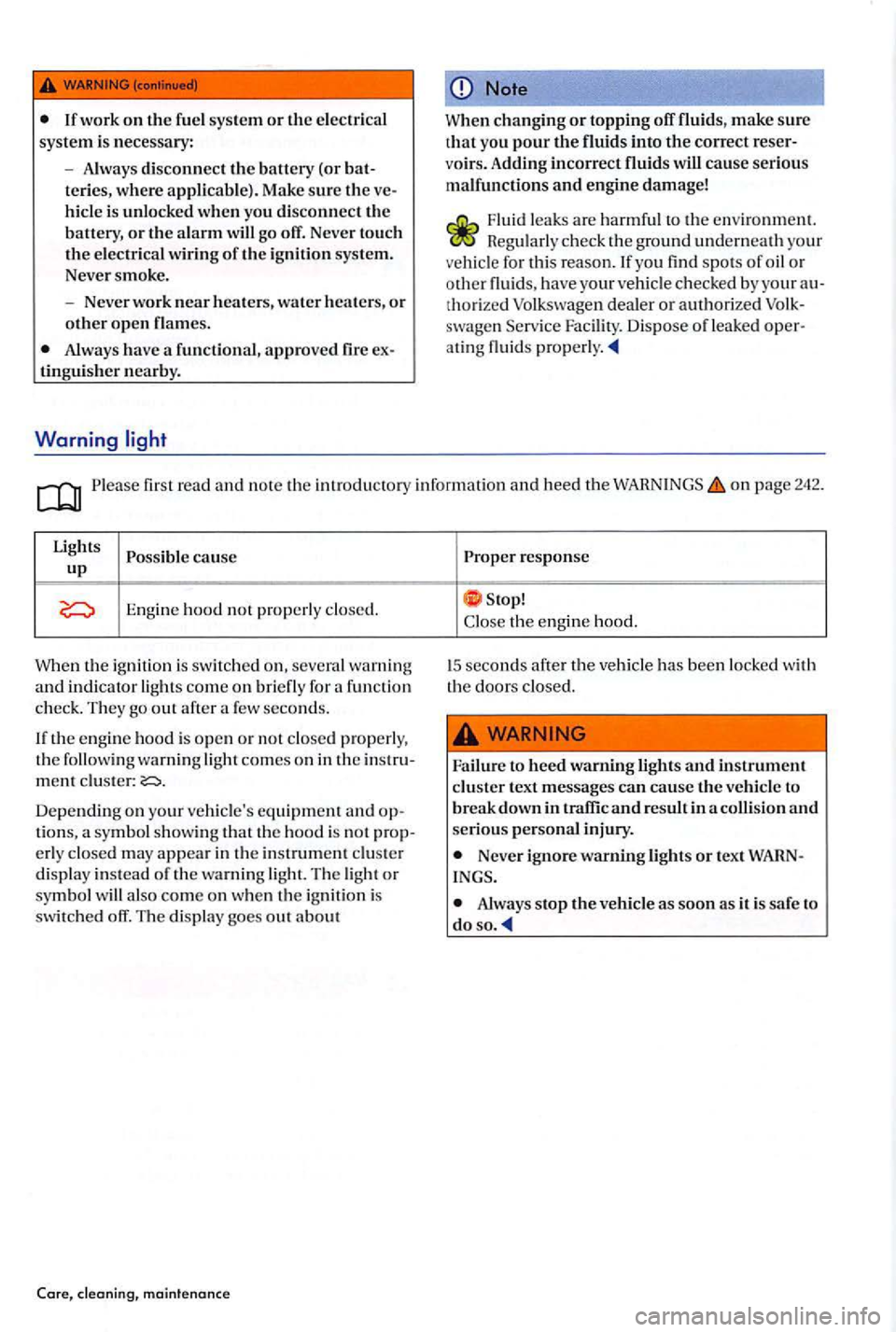
Always disconnect the batt ery (or teries, where appli cable). Make sure the hicle is unlocked when you disconnect the battery, or th e alarm w ill go off. Never touch the electrica l w irin g of the ign ition sys te m .
Neve r smoke.
Never work near heaters, water heaters, or other open flames.
Always have a functional, approved fire tinguisher nearby.
Warning
Note
W hen c
hangin g or topping off fluid s, make sure that you pour the fluids into the correct voirs. Addin g incorrect fluids will cause serious
malfunc tions and engine damage!
Fluid leaks are harmfu l to the environm ent.
thori zed Volkswagen dealer or authori zed swagen Serv ice Faci lity. Dispose of le aked at ing fluid s
first read and note the in tr o du ctory informat io n and heed th e on p age 242.
Lights ca use up
Engine hood not proper ly closed.
When the ignition is sw
itched on, several warning
a nd in dicator light s co me on bri efly fo r a functio n
c h eck. They go out after a few seconds.
If th e engi ne hood is open or not clos
ed properly,
the following warning light comes on in the ment cluster:
tions , a sy mbol showing th at the hood is not erly clo sed may appea r in th e in stru ment clu ste r
di splay instead of the warnin g light . Th e light or sy mbo l will als o com e o n whe n th e ig nition is swit ched off. T he di splay goe s out about
Core,
response
Close the eng ine hood.
I S seconds
after the vehicle has been locked with
the doors closed.
Failure to heed warning lights and instrument cluster text messages can cause the vehicle to
break down in traffic and res ult in a co llision and se riou s personal injury.
Never ignore warning lights or text
Always stop the vehicle as soo n as it is safe to do